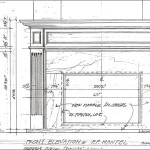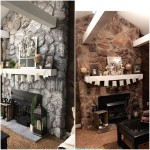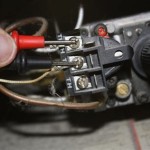```html
Fireplace Tile Pattern: Design, Considerations, and Installation
Fireplace tile represents a crucial element in both the aesthetic appeal and functional safety of a fireplace. The tile covering the firebox surround and hearth protects combustible materials from excessive heat and provides an opportunity to enhance the room's overall design. A well-chosen tile pattern can transform a standard fireplace into a focal point that reflects the homeowner's style and complements the architectural elements of the space. This article will explore various fireplace tile patterns, detailing design considerations, essential safety protocols, and key installation techniques.
Understanding the Role of Fireplace Tile
Before delving into specific patterns, it is essential to understand the fundamental purpose of fireplace tile. Primarily, it acts as a non-combustible barrier, shielding the surrounding wall structure from the intense heat generated by the fire. This is particularly important for fireplaces surrounded by wood, drywall, or other flammable materials. The tile extends beyond the firebox opening (the surround) and often includes the hearth, the floor area directly in front of the fireplace. The hearth provides a protective zone to prevent sparks or embers from damaging the flooring.
Beyond its functional role, fireplace tile serves as a decorative component. The selection of tile material, color, size, and pattern significantly impacts the room's ambiance. Tile can be used to create a traditional, rustic, modern, or eclectic look, depending on the homeowner's preference. From classic subway tile to intricate mosaics, the possibilities are virtually limitless.
The selection of tiles should also strongly consider the type of fireplace. Wood-burning fireplaces generate more heat than gas fireplaces, requiring more robust and heat-resistant tile materials. Gas fireplaces often allow for a wider range of tile options, including materials that might be susceptible to cracking under extreme heat.
Exploring Fireplace Tile Patterns
The choice of a fireplace tile pattern directly affects the visual impact of the fireplace. Several popular patterns exist, each offering a distinct aesthetic. Understanding these patterns and their characteristics is crucial for selecting the most appropriate design for a specific space.
Subway Tile: This classic pattern consists of rectangular tiles, typically arranged in a horizontal offset or running bond pattern, similar to the tiles found in subway systems. Subway tile offers a clean, timeless look that works well with various design styles. It is often chosen in white or cream colors for a minimalist aesthetic but can also be found in a wide range of other colors and finishes.
Herringbone: The herringbone pattern is created by arranging rectangular tiles in a zig-zag formation. This pattern adds visual interest and a touch of sophistication to the fireplace. The angle of the herringbone pattern can be adjusted to create different effects, such as a more subtle or dramatic look. Herringbone is often used with longer, narrower tiles to accentuate the angular design.
Stacked: A stacked pattern involves arranging tiles directly on top of each other in neat rows and columns. This pattern creates a clean, modern look and emphasizes the shape and color of the tiles. Stacked patterns work well with square or rectangular tiles and can be oriented horizontally or vertically. A vertical stacked pattern can visually heighten a room.
Mosaic: Mosaic tile patterns involve using small pieces of tile to create intricate designs or images. Mosaics offer a high degree of customization and can be used to create unique and personalized fireplace surrounds. They can incorporate various colors, shapes, and materials to achieve a wide range of artistic effects. Examples include geometric patterns, floral motifs, and even custom portraits.
Chevron: Similar to herringbone, the chevron pattern features angled tiles, but instead of the tiles overlapping, they meet to form a continuous zig-zag line. This creates a more pronounced and geometric pattern than herringbone. Chevron patterns can be visually striking and add a bold statement to the fireplace area.
Random: A random pattern involves arranging tiles of different sizes, shapes, and colors in an apparently arbitrary manner. While seemingly unstructured, a well-executed random pattern requires careful planning to ensure balance and visual harmony. This pattern can create a more relaxed and informal look, perfect for rustic or eclectic interiors.
Large Format: Using large-format tiles (tiles with larger dimensions) can minimize grout lines and create a seamless, contemporary look. Large-format tiles are often used in a stacked or running bond pattern to showcase the tile's surface and minimize visual clutter. The use of large format tiles can require special installation techniques to ensure proper adhesion and leveling.
Key Considerations for Selecting Fireplace Tile
Choosing the right fireplace tile involves carefully considering several factors, including the fireplace type, the overall design aesthetic, and practical considerations such as heat resistance and maintenance. Overlooking these factors can lead to dissatisfaction with the final result or, in some cases, safety hazards.
Material Selection: Different tile materials possess varying degrees of heat resistance and durability. Common choices include ceramic, porcelain, natural stone (such as marble, granite, and slate), and glass. Porcelain and natural stone are generally more heat-resistant than ceramic and are better suited for wood-burning fireplaces. Glass tiles are typically used for decorative accents or in gas fireplaces where heat is less intense. It is vital to consult with a tile professional to determine the appropriate material for the specific fireplace application.
Color and Texture: The color and texture of the tile should complement the overall design of the room. Lighter colors can make a space feel larger and brighter, while darker colors can create a more dramatic and intimate atmosphere. Textured tiles can add visual interest and depth to the fireplace surround. Consider how the tile will interact with the existing wall color, furniture, and flooring.
Size and Shape: The size and shape of the tiles should be proportionate to the size of the fireplace and the surrounding wall area. Smaller tiles are often used for intricate patterns or mosaics, while larger tiles can create a more streamlined and modern look. The shape of the tile can also influence the overall aesthetic. Rectangular tiles are versatile and can be used in various patterns, while square tiles offer a more geometric and balanced appearance.
Grout Selection: Grout fills the spaces between the tiles and plays a crucial role in both the appearance and durability of the tile installation. The color of the grout can significantly impact the overall look of the fireplace. A contrasting grout color can emphasize the shape and pattern of the tiles, while a matching grout color can create a more seamless and uniform appearance. Epoxy grout is more resistant to stains and moisture than cement-based grout and is often recommended for fireplace applications.
Heat Resistance: All materials used in a fireplace installation must be able to withstand high temperatures. Look for tiles that are specifically rated for fireplace use. This will help prevent cracking and damage to the tile. Mortar and grout must also be high-temperature rated.
Installation Techniques and Safety Procedures
Proper installation is crucial to ensure the safety and longevity of the fireplace tile. While experienced DIYers may be able to tackle this project, professional installation is often recommended, particularly for complex patterns or when working with natural stone.
Preparation: The surface to which the tile will be applied must be clean, level, and structurally sound. Remove any existing tile, paint, or debris. If necessary, apply a cement backer board to create a stable and fire-resistant substrate. The backer board provides a suitable surface for the mortar to adhere to and helps to protect the underlying wall structure.
Layout and Planning: Before applying any mortar, dry-fit the tiles to plan the layout and ensure that the pattern is centered and balanced. This allows for adjustments and corrections before the permanent installation. Use spacers to maintain consistent grout lines and create a uniform appearance.
Mortar Application: Apply mortar to the backer board using a notched trowel, creating ridges that help the tile adhere properly. Press each tile firmly into the mortar, twisting slightly to ensure good contact. Remove any excess mortar from the surface of the tile immediately.
Cutting Tiles: Use a tile saw or tile nippers to cut tiles to fit around the firebox opening or other obstacles. Exercise caution when using power tools and wear appropriate safety gear, such as eye protection and gloves.
Grouting: Once the mortar has cured, apply grout to the spaces between the tiles using a grout float. Work the grout into the joints, filling them completely. Remove excess grout from the surface of the tile with a damp sponge. Allow the grout to dry according to the manufacturer's instructions, then buff the tile with a clean cloth to remove any remaining grout haze.
Sealing: Some tile materials, such as natural stone, may require sealing to protect them from stains and moisture. Apply a sealant according to the manufacturer's instructions. Regular maintenance and cleaning will help to keep the fireplace tile looking its best for years to come.
Safety Precautions: When working with tile and mortar, it is essential to wear appropriate safety gear, including eye protection, gloves, and a dust mask. Work in a well-ventilated area to avoid inhaling dust or fumes. Always follow the manufacturer's instructions for the use of tools and materials.
Proper planning and execution are key to a successful fireplace tile installation. Taking the time to carefully select the appropriate tile and pattern, prepare the surface properly, and follow established installation techniques will result in a beautiful and functional fireplace that enhances the enjoyment of the space.
```
Fireplace Tile Ideas Designs To Inspire You

Fireplace Tile Ideas Designs To Inspire You

Fireplace Tiles Fire Surround Hearth

Hot Fireplace Tile Trends Bedrosians Stone

Fireplace Feature Wall Ideas Queen City Stone Tile

Diy Projects Tiling A Fireplace Like Pro Rubi Blog Usa

30 Best Fireplace Tiles Ideas For Your Mantel Remodel Home Design Decor

30 Most Beautiful Fireplace Tile Ideas For 2024 Decor Home Design Surround

Fireplace Tiles Ideas And Patterns Rubi Blog Usa

30 Best Fireplace Tiles Ideas For Your Mantel Remodel Farm House Living Room Retro Home Decor
Related Posts








